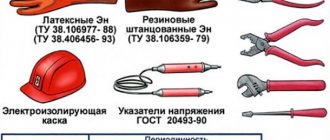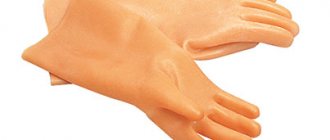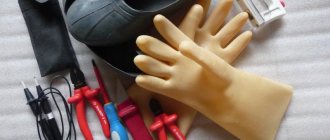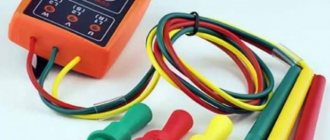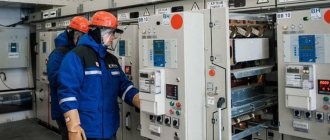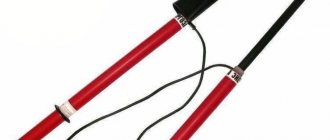When working with electrical devices, following safety rules is very important. One of the key points is the use of electrical protective equipment, which are items that protect a person from the effects of electric current. At the same time, it is important to know what insulating electrical protective equipment is used in electrical installations and what exactly they are intended for, as well as to monitor their condition, including timely inspection and replacement.
What types of electrical protection means there are and what are the testing times for electrical protective equipment will be discussed in this article.
Purpose of dielectric mats
Dielectric mats are considered an additional means of protection. If a worker works with live wires, it is likely that the current will pierce rubber gloves, boots or galoshes and other protective equipment. This is especially dangerous when the electrical appliance is not grounded. If work occurs in areas where humidity is high, this makes working with live devices even more dangerous. It is necessary to apply protective equipment comprehensively to guarantee the safety of the employee.
There are regulatory requirements that when working with voltages exceeding 1000 volts, the use of a mat and other methods of protection is mandatory.
Additional PPE
Inspection and testing periods of dielectric protective equipment
An item used for electrical protection must have a special stamp indicating the following parameters:
- Name;
- manufacturer;
- date of manufacture;
- test period.
The last parameter is so important that if it is missing or the check expires, it is prohibited to use the tools in your work. The use of this electrical protection is a violation of safety regulations that carries a risk to life.
The first test of electrical protective equipment is carried out after production of the product, subsequent tests - after certain periods. The timing of testing electrical protective equipment is specified in GOST and TU. The same documents stipulate the conditions and time of test work, as well as the frequency of inspections, which are usually carried out more often and can be either an independent diagnosis or a preliminary stage of verification. The assessment of the mechanical and electrical qualities of protective equipment is usually carried out in specialized organizations.
Below is a table indicating the frequency of testing electrical protective equipment.
Classification
It is customary to use the following types of rugs:
- Ordinary rug. It is characterized by a short service life and relatively low cost. It can be used at temperatures ranging from -15 to +40 degrees.
- Mid-range mats are made from higher quality rubber, which ensures a longer service life.
- A product that is resistant to chemically aggressive environments. Usually used in conjunction with a special stand. If the mat is used in aggressive conditions, its service life does not exceed 3000 hours.
Products usually have a fixed size. Depending on it, the price of the product is determined:
- The width ranges from 60 to 120 cm.
- The length can be different: from 50 cm to 8 m.
- In most cases, the thickness is 5-7 mm.
The price, depending on the size of the rug, is 100-500 rubles. Middle class rugs can be purchased for 3-5 thousand rubles. If oil and petrol resistant mats with stands are sold, their price can be 5 thousand rubles or more.
Also read: Single-phase dry transformer - OSM
If mats are used in aggressive environments, then special requirements are placed on them. The materials from which they are made are not subject to destructive effects. The stands are made of hard, inflexible material. Their thickness can be 7 cm or more. Typically, stands are made from bars spaced several centimeters apart.
Not only products of standard sizes can be used, but also those that are made to order. In this case, the shape of the mat can be made according to customer requirements.
Frequency of testing electrical protective equipment
| Name of the protective equipment | Test frequency |
| Dielectric mats | No testing required, visual inspection is carried out |
| Electrical insulating rods | Once every 24 months. |
| Measuring rods | Once every 12 months. |
| Electrical insulating pliers | Once every 24 months. |
| Electrical clamps | Once every 24 months. |
| Voltage indicators up to and above 1000V | Once every 12 months. |
| Electrical insulating gloves | Once every 6 months. |
| Electrical insulating boots | Once every 36 months. |
| Electrical insulating galoshes | Once every 12 months. |
| Electrical insulating pads | Once every 24 months. |
| Cable piercing device | Once every 12 months. |
| Electrical insulating caps | Once every 36 months. |
| Electrically insulating ladders and stepladders | Once every 6 months. |
| Hand-held electrical insulating tool | Once every 12 months. |
Requirements for rugs
The main function of such a product is electrical insulation between the worker’s feet and the floor. However, in order for the mat to perform its task. It must comply with the requirements of regulatory documents. To do this, the mats must have the following characteristics:
- It is necessary that the product can withstand a large number of bends without losing its properties.
- If the mat is stored in a warehouse, its characteristics must remain unchanged for 3 years. After this period, the mat must be changed even if it seems that no external changes have occurred.
- The surface of the mat on which a person stands must be corrugated. This is necessary to prevent slipping. In appearance, the structure of the product should look uniform.
- The presence of shells or bubbles on the grooved or smooth part is not allowed.
- The mat must withstand a voltage of 10 kV per 1 mm. In this case, the amount of leakage current must be limited.
- They are made from special rubber that has the necessary dielectric properties. The depth of the gaps when corrugating should be 1-3 mm.
- It is necessary that when bending in two perpendicular directions, even the smallest cracks cannot be seen at the fracture.
Rubber has the ability to change its physical characteristics over time. Therefore, you cannot rely on the reliability of an old rug. Such products become brittle and lose their ability to provide insulation from electric current.
Also read: Three-phase power transformer - TMG
TECHNICAL REQUIREMENTS
1.1. Carpets must be manufactured in accordance with the requirements of this standard according to technological regulations approved in the prescribed manner.
1.2. Depending on the purpose and operating conditions, dielectric rubber carpets should be manufactured in two groups:
1st - for operation at temperatures from minus 15 to plus 40 ° C;
2nd - oil and petrol resistant, for operation at temperatures from minus 50 to plus 80 °C, while at plus 80 °C - no more than 3000 hours.
1.3. Carpets must be made in the following sizes: length from (500±10) mm to (1000±10) mm, over (1000±30) mm to (8000±30) mm; width from (500±10) mm to (1200±10) mm; thickness (6±1) mm.
Example of a symbol
Carpet of the 1st group with a length of 8000 mm and a width of 500 mm:
Carpet-1-8000x500
GOST 4997-75
(Changed edition, Amendment No. 3, 5).
1.4. Carpets must have a corrugated front surface. The depth of the reefs should be 1-3 mm; the corrugation pattern can have any shape that ensures the anti-slip properties of the carpet.
(Changed edition, Amendment No. 3).
1.5. Carpets must be one color. The color is set in agreement with the manufacturer.
1.6. Cracks, foreign inclusions, holes, as well as cavities with a depth and bubbles with a height of more than 1 mm and a diameter of more than 4 mm in an amount of more than 6 pieces are not allowed on the front surface of the carpets. per 1 m length.
(Changed edition, Amendment No. 3, 7).
1.7. On the non-face surface of the carpet, shells with a depth of more than 1.5 mm, a length of more than 35 mm and a width of more than 20 mm, bubbles with a height of more than 1.5 mm, and a diameter of more than 5 mm are not allowed. The total number of shells and bubbles should be no more than 6 pieces. per 1 m length.
— on the front surface there are small flaws in the design and its under-pressing, as well as different colors;
- on the non-facial surface - imprints of the fabric texture;
- on the front and non-front surfaces - traces of anti-adhesive, bubbles with a diameter of no more than 2 mm, a height of no more than 1.5 mm, without limiting their number; bubbles with a diameter of no more than 4 mm, a height of no more than 1.5 mm in an amount of no more than 6 pcs. on each surface for molded carpets with dimensions of 500x500 mm and 650x650 mm; at a distance of no more than 50 mm from the edges - appearance deviations specified in paragraphs 1.6 and 1.7, without limiting their number;
— it is allowed to establish the appearance of carpets according to agreed upon samples.
(Changed edition, Amendment No. 5, 7).
1.8. Carpets must withstand a test voltage of 20 kV AC at 50 Hz.
1.9. The permissible maximum carpet leakage current should be no more than 160 mA/m.
1.10. The electrical strength of rubber used for making carpets must be at least 10 kV/mm.
1.9, 1.10. (Changed edition, Amendment No. 2).
1.11. In terms of physical and mechanical properties, rubber used for the manufacture of carpets must comply with the standards specified in Table 1.
Standard for rubber for group carpets
Tests
Before using them, you need to make sure that the mats have not lost their protective properties. To do this, it is necessary to carry out a check.
First you need to inspect the product. To make sure there are no cracks, you need to bend the mat several times. If stands are used, they should be inspected to show no chips or cracks.
If there are no mechanical damages, electrical breakdown tests are performed. For this purpose, the appropriate voltage is applied. Tests are carried out at a temperature of 15-40 degrees and a humidity of 45-75%.
If deficiencies are found, the products must be replaced. If the mats are in storage, they are checked every three years.
We study the timing of testing electrical protective equipment
When working with electrical devices, following safety rules is very important. One of the key points is the use of electrical protective equipment, which are items that protect a person from the effects of electric current. At the same time, it is important to know what insulating electrical protective equipment is used in electrical installations and what exactly they are intended for, as well as to monitor their condition, including timely inspection and replacement.
What types of electrical protection means there are and what are the testing times for electrical protective equipment will be discussed in this article.
Storage
Conditions of detention significantly affect the safety of products and their readiness for use. In order for rugs to be stored for a long time, the following rules must be followed:
- It is recommended to create suitable storage conditions. Suitable temperature is 20-25°C.
- If the rug was brought in from the cold, it is not recommended to use it immediately. It needs to be kept at room temperature for an hour.
- Do not store in close proximity to heating appliances.
- If the product becomes dirty after use, it must be cleaned. In this case, alcohol solutions cannot be used. As a result of use, the mat will harden.
- When using a mat, you need to make sure that there is no moisture on it. If this is not the case, you need to let it dry completely.
- If work takes place in cold rooms, the product intended for such conditions must be kept at room temperature for an hour. Otherwise, the insulating properties of the mat will be compromised, putting the worker's life in danger.
Products are stored in rolls or placed in packs. It is important that deformation does not occur during storage.
Checking protective equipment
The dielectric and insulating support are subject to periodic diagnostics for breakdown and integrity of materials. Before use, an external inspection of the mats is carried out; checking for cracks in the material is carried out during bending of the plastic structure. It is recommended to inspect the stands for the presence of chips on the legs and bedding.
If defects are found, mats, flooring and other protective equipment must be replaced. If the stands do not move, then diagnostics are carried out at least once every 3 years. If the defect can be eliminated, then the dielectric must be checked for breakdown in accordance with the standards.
To prevent premature wear of rubber coatings, it is recommended to follow the following rules for using products:
- Mats are stored at a temperature of 20-25 degrees.
- Before using coatings that were brought in from the cold, you need to let them warm up in a warm room for about a day.
- Oily surfaces are immediately cleaned without using alcohol solutions to prevent the rubber from becoming hard.
- Personnel should not use wet surfaces during work.
- In cold rooms, a specialized dielectric mat, gloves, and stands are used. There are products that can withstand temperatures from -50 to +80 degrees.
Carpet dielectric service life. Testing of dielectric mats
The surface of the mat is corrugated and anti-slip, the depth of the grooves is about 1-3 mm. The material can withstand voltages up to 20 kV with a frequency of 50 Hz. The leakage current is measured, which does not exceed 16 Ohm A/sq. m. The structure of the appearance should be uniform, dark tones predominate in it.
Checking protective equipment
The dielectric and insulating support are subject to periodic diagnostics for breakdown and integrity of materials. Before use, an external inspection of the mats is carried out; checking for cracks in the material is carried out during bending of the plastic structure. It is recommended to inspect the stands for the presence of chips on the legs and bedding.
If defects are found, mats, flooring and other protective equipment must be replaced. If the stands do not move, then diagnostics are carried out at least once every 3 years. If the defect can be eliminated, then the dielectric must be checked for breakdown in accordance with the standards.
To prevent premature wear of rubber coatings, it is recommended to follow the following rules for using products:
- Mats are stored at a temperature of 20-25 degrees.
- Before using coatings that were brought in from the cold, you need to let them warm up in a warm room for about a day.
- Oily surfaces are immediately cleaned without using alcohol solutions to prevent the rubber from becoming hard.
- Personnel should not use wet surfaces during work.
- In cold rooms, a specialized dielectric mat, gloves, and stands are used. There are products that can withstand temperatures from -50 to +80 degrees.
Electrical protective equipment
337. Electrical protective equipment used in State Fire Service units includes:
dielectric rubber gloves;
rubber dielectric galoshes (overshoes);
dielectric rubber mats measuring at least 50 x 50 cm with a corrugated surface;
scissors for cutting electrical wires with insulated handles (requirements for the specified electrical protective equipment are determined by GOST);
portable grounding electrodes made of flexible copper conductors of arbitrary length, with a cross-section of at least 12 mm2 for fire engines, in which the main protection system is protective grounding.
338. Tests of electrical protective equipment are carried out by special laboratories that have permission from the State Energy Supervision authorities. The test results are documented in a report, which is stored in the State Fire Service department until the next test. On gloves, boots, mats, etc. a stamp is placed indicating the date of the next test.
339. Test timing:
dielectric rubber gloves – once every 6 months;
dielectric rubber galoshes - once every 3 years;
dielectric rubber boots - once every 3 years;
scissors for cutting electrical wires with insulated handles - once a year.
Rejection of rubber dielectric mats during external inspections at least once a year.
340. The suitability of protective insulating means for operation is determined by external inspection and testing. An external inspection is carried out daily upon reporting to combat duty by the personnel of the State Border Guard units to which they are assigned.
341. External signs that determine the unsuitability of electrical protection means are:
for scissors – damage to the insulation on the handles and the absence of thrust rings and rubber bushings at the ends of the handles;
for rubber gloves, galoshes (bottoms), rugs - punctures, tears, holes;
for portable grounding – destruction of contact connections, violation of the mechanical strength of copper conductors (breakage of more than 10% of copper conductors).
Product description:
Dielectric carpets
Dielectric rubber carpets and insulating supports are used as additional electrical protective equipment in electrical installations up to and above 1000 V.
Carpets are checked for test voltage and leakage current using alternating current with a frequency of (50÷0.2) Hz at (25±10) 0C and relative humidity (45-75)%
Carpet testing is carried out using one of three methods.
Carpets are pulled between metal rollers with a diameter of 200±25 mm, which serve as electrodes. The lower roller is grounded and driven forcibly at a speed of (3±0.3) cm/s.
The upper roller is connected to a high voltage source and rotates freely. The length of the electrodes should ensure that the entire width of the carpet is tested, with the exception of 50 mm on each side of the carpet.
A test voltage of 20 kV is applied to the electrodes and removed from them at a distance of 50 mm from the line of contact of the electrodes to the edges of the carpet.
The test is carried out on carpets with dimensions of 750x750 mm. Water is poured into a metal bath, which serves as a grounded electrode. The carpet sample to be tested is then placed in the bath so that its edges protrude approximately 50mm above the edges of the bath.
Water is poured onto the front surface of the test sample and the second electrode is lowered. In this case, the edges of the test sample, approximately 50 mm wide, must remain dry. The beginning of the test is taken to be the moment the voltage reaches 20 kV.
The sample is maintained at this voltage for 1 minute. The leakage current should be no more than 67 mA.
The carpet is placed between two flat electrodes. The corners and side surfaces of the electrodes must be rounded. The radius of curvature of the side surface of the electrodes should be equal to half the thickness of the electrode.
The size of the electrodes should be such that their edges do not reach the edges of the carpet on each side by 50 mm. It is allowed to use electrodes whose area is smaller than the area of the carpet.
In this case, the tests are carried out sequentially over the entire surface of the carpet in such a way that adjacent test areas of the carpet surface are not subjected to the test voltage more than once.
The alternating voltage of industrial frequency 50 Hz is gradually increased to 20 kV, after which it is maintained for 1 minute. Monitor the leakage current, which should be no more than 160 mA/m2.
GOST states that the first method is more preferable, but it is difficult to implement. The second method is applicable only for carpets with a size of 750x750 mm, but the third method is the easiest to use.
Standards and frequency of electrical testing of dielectric mats.
172. Dielectric rubber mats (mats) are tested by passing them at a speed of 2-3 cm
in 1
sec
between cylindrical electrodes.
To measure the currents flowing through the rug, an ammeter is connected to the electrical circuit. The breakdown of the mat is recorded using a voltmeter.
It is allowed to test mats in a metal bath filled with water, just like rubber insulating pads (see paragraph - 179).
173. The amount of current flowing through the mat should not exceed 1 mA/1000 V test voltage.
The test voltage is set:
a) for dielectric mats manufactured according to GOST for electrical installations with voltages above 1000 V-20 kV;
b) for rugs used in electrical installations with voltages up to 1000V -3.5 kV.
Testing of insulating stands
174.-Electrical and mechanical tests of stands are carried out only after their manufacture and major repairs.
175.
Testing of insulating supports for mechanical strength is carried out before the electrical test and consists of subjecting the assembled insulating support to a uniformly distributed load of 350 kg/ m2
for at least 1
minute.
In this case, there should be no deflection of the stand flooring and other deformations - cracks, violations of the integrity of the support insulators, weakening of the connection between individual parts of the flooring, kinks, etc.
After production, the platforms are also tested for tipping (clause 106).
If any of the listed defects are detected, the insulating stand is rejected.
176. Electrical tests of insulating supports consist of testing support insulators.
When performing electrical tests, the following conditions must be met:
a) the test voltage must be equal to 40 kV, regardless of the voltage of the electrical installation for which the stands are intended;
b) the duration of the test should be 1 minute;
c) supporting insulators of insulating supports can be tested either separately or together with the flooring; in the latter case, before testing, the support insulators are connected by wire to the top and bottom bases separately, after which voltage is applied from one of the terminals of the test transformer to the upper bases, and from the other terminal directly or through the ground to the lower bases of the insulators.
177. While the insulators are under voltage, it is necessary to carefully monitor their condition: if sliding discharges or overlaps occur, the stand is rejected.
After testing, an inspection stamp is placed on the support insulators (ends).
Rejected support insulators are broken, insulating supports are completely or partially repaired, after which they are subject to retesting,
Testing of insulating linings
178. Insulating linings made of bakelite, textolite, plastics, etc. must be tested for breakdown and overlapping on the surface with a voltage of 20 kV for 5 minutes.
To test the pads for breakdown, each electrode must have
the surface of contact with the lining is at least 50% of one side surface of the lining.
Testing of linings for surface overlap should be carried out using electrodes of any size applied on each side of the lining.
The distance between the electrodes along the surface of the pad should be no more than the distance between the poles of the disconnector for a voltage of 10 kV.
The condition of the linings during testing should be monitored in accordance with the instructions in paragraph - 146.
179. After manufacturing, insulating rubber pads must be tested at a voltage of 5 kV in a special metal bath.
Water poured into the bath over the lining should not reach the edges of the lining on the outer and inner sides by 50 mm. One terminal of the test transformer is connected to a grounded bath, and the second is connected to an electrode placed at the input on top of the pad.
To measure the current flowing through the pad, a milliammeter is connected to the step-up winding circuit of the transformer. The current should not exceed 5 mA. Test duration is 1 min.
You can also test by passing pads between cylindrical electrodes, just as dielectric mats are tested (section 172).
Periodic tests of rubber pads are carried out, as indicated above, in a bath by applying a voltage of 3.5 kV for 1 min. The current should not be more than 3.5 mA.
- Site Map
- Feedback
Source: https://svetvtebe.ru/carpet-dielectric-lifetime-tests-of-dielectric-mats/
